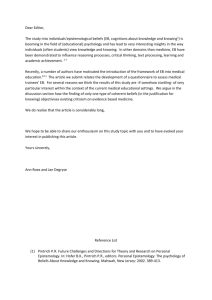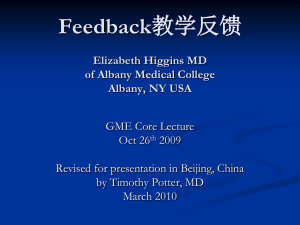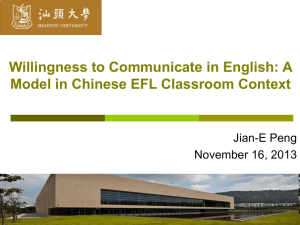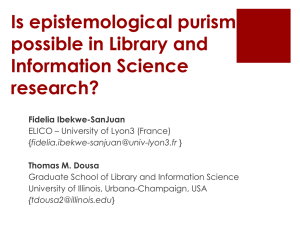EDF 5807 week 1 becoming a teacher learning and
advertisement
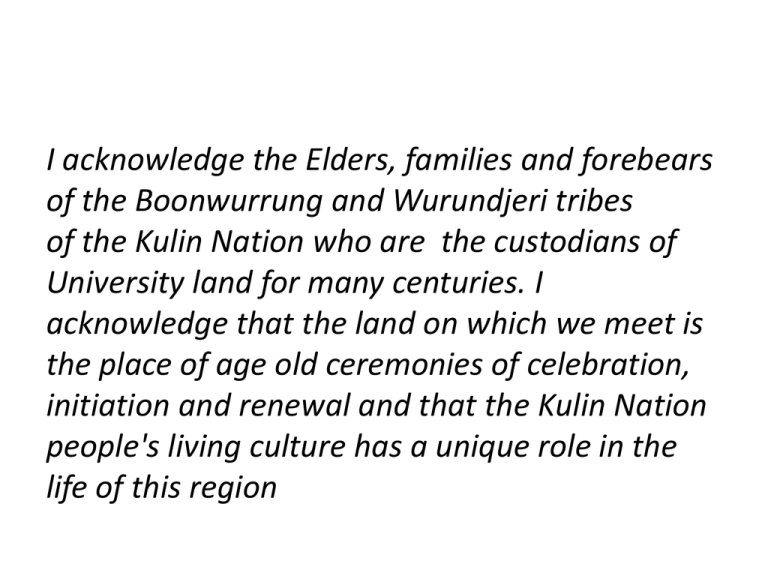
I acknowledge the Elders, families and forebears of the Boonwurrung and Wurundjeri tribes of the Kulin Nation who are the custodians of University land for many centuries. I acknowledge that the land on which we meet is the place of age old ceremonies of celebration, initiation and renewal and that the Kulin Nation people's living culture has a unique role in the life of this region EDF 5807 Theory and practice of learning and teaching Ian Mitchell Week 1 Becoming a teacher: learning and teaching Structure of this course • It is a new course, replacing Dip Ed as our end on qualification • Masters level so subjects are 12 point –bigger but you do fewer than in Dip Ed • Based on 36 contact hours, but only 21 of these are in lectures and tutorials • Two workshops and on-line activities making use of what is rapidly developing technology Ian, Anita and Jenny as learners • This involves us in some new pedagogy and we will be learning how best to structure this • There are no rats in teaching • We will be getting feedback from you, but it is certain that 2014 will have some refinements • This is a standard feature of teaching that is built into system expectations of teachers Our professional learning teams and learning logs • You will each be in a team of about 5 in your tute • Each team will share a learning log where you will share insights and ideas in a range of aspects of teaching both in course time and, we hope, during the practicum • Teams will sometimes share their insights in tutorials • We will contribute as appropriate • You will run a microteach for your team in the week 3 workshop Task 1 –analysing two videos • There are videos from the classrooms of two teachers researching how to develop their students as “better” learners • The first question provides one reason why we are not offering these as models for you to replicate in your practicum • After this first task, we will return to this footage with a more sophisticated lens in week 3 One of my Big ideas Teaching is complex and multi-faceted with a range of interconnected skills. In other words we challenge perceptions that it is an innate and relatively simple operation based around teacher telling and student listening Becoming a teacher (Sullivan) • Peter talks about the Science and Art of teaching • Science knowledge of teaching is typically grounded in research on learning and teaching • This is what I do! Artistry in teaching But classrooms are too complex and unpredictable to reduce teaching to following proven, singular ‘best’ approaches Peter Corkill and Pythagoras patterns • What was the dilemma that confronted peter when Andrew noticed a pattern in the numbers? • What were the risks that Peter took? • In deciding to abandon his lesson plan and respond to what happened when he did, Peter was displaying aspects of the artistry of teaching • Can artistry be documented, codified, taught? • This is part of my research with teachers like Peter, Bree and Sarah Craft aspects of teaching • Craft knowledge is commonly learnt under the direction of an experienced practitioner • It includes advice on how to deal with common situations • It is best learnt in situ • Classroom management has significant elements of craft knowledge Teaching is complex There are many core skills of teaching: -planning -generating interest, motivation and engagement -communication -classroom leadership and management -promoting quality learning and building quality learners for a rapidly changing world Core skills of teaching (cont.) -assessment -reporting -being responsive to unexpected events -pastoral care -solving classroom problems -using ICTs to enrich pedagogy Teachers use different classroom practices and each of these involves a different set of skills • Note giving/taking • Group work • Class discussion • Drill and Practice • Text reading • Practical work • Problem solving tasks • Research tasks How many of these can we teach • • • • By week 4? By week 6? This semester? In this course? Blended learning 3 Next week I hope to shoot some sessions of about 15 minutes each of some skills of teaching that I cannot deal with in these lectures: • Group work • Generating interest/need to know • Roles of Teacher questions Probably Wednesday morning, I would prefer to do this with a group of 8-10 of you Online task • I plan to video segments of 15-20 minutes on some teaching skills I cannot fit into our lectures • I would prefer to do these with some volunteer students so it is interactive • I cannot close on the date today, but I am thinking of Wednesday morning nest week Big Idea 2 Becoming a teacher is a journey that takes years and is based on reflection, willingness to try new approaches and, critically a willingness to problematize your practice –to not accept superficial signs of success such as students apparently being on task but to drill beneath this to check what, if and how students are learning How can we begin to address all the many aspects of teaching? It is very dependent on you to • Read widely • Share • Reflect • Try approaches a little outside your comfort zone • Problematize your practice Teacher’s classroom behaviours flow from their beliefs about learning and how understandings are constructed (epistemological beliefs) In these two role plays what can you infer about differences in the teachers epistemological beliefs? Role plays • Context A: Historical discussion introducing To Kill a Mockingbird • Context B: Discussion of the final digit of 75 28th February 2011 Presentation title 21 History teacher Maths teacher Barnes 1975, two types of teacher beliefs and values Transmissive 1. 2. Interpretive Believe knowledge to exist in the form of public domains which include content and criteria for performance Perceives the teacher’s task to be the evaluation and correction of the learner’s performance according to the criteria of which he (sic) is the guardian 28th February 2011 1. Believes knowledge is constructed by the learner 2.Perceives the teacher’s task to be the setting up of a dialogue in which the learner can reshape his knowledge through interaction Presentation title 23 Ideas from this lecture, Barnes 1975, 2 types of teacher beliefs and values Transmissive 3.Perceives the learner as an uninformed acolyte 28th February 2011 Interpretive 3.Perceives the learner as already possessing relevant knowledge and the means of reshaping that knowledge Presentation title 24 Barnes did not intend a dichotomy and this exercise is not intended to set up a dichotomy Teacher beliefs/values and teacher behaviours • Several studies suggest (Levinson and Turner, 2002; Putnam and Borko 1997; Hildebrand, 2007; Ratcliffe, 2007; Pajares, 1992; Loughran, 2002;) there is a strong link between beliefs, values and behaviour in the classroom What will you be attending to in your classrooms? Gomez (2013) found that a critical element of what teachers did in the classroom came from what they were attending to as important – what she called their epistemological beliefs This caused me to reflect on how this developed during my teaching career 1974/5 • Students would make connections to daily life hence I encouraged students to make such links and gave them serious class time and learnt to capitalise on such incidents • My unit had a coherent narrative where understandings of concepts would build over different activities hence I was looking for links to key ideas but it did not occur to me to get students thinking about how different activities might be connected by the same idea 1974/5 • Students need to experience success hence look for opportunities to give genuine praise • Students should be engaged with ideas, not just completing tasks so encourage lateral questions and give them respect • Students should enjoy my lessons, so tell engaging stories and build mutually respectful relationships with students 1982: exposure to research on children’s prior views • Students need to reflect on and share their own ideas hence I needed to run discussions where I used delayed judgement (Barnes) and extended wait time (Budd-Rowe, 1974) • Students need to reflect on changes to their ideas and this did not happen in a single incident hence I needed to get at key ideas in multiple ways • Both of the above meant that I needed to promote and value talk that was tentative, exploratory and hypothetical So what will you be attending to and how might this develop over your practicum experiences Surface v Deep Processing This model describes two different approaches to learning. It focuses on what the learner wants to achieve. SURFACE PROCESSING DEEP PROCESSING Focus is on what is need to complete the task. Focus is on what is needed to gain rich understanding of this content. 1. concentrating on the concrete and literal aspects of tasks/ideas - the actual words used searching for underlying meanings and reasons as well as aspects which are unclear 2. Seeking only to get the task done – 'what to do' Seeking to understand the task – 'why does this work?' 3. finding answers by semantic and contextual clues in text constructing answers by building understanding of text 4. is happy to remain totally dependent on seeking to complete tasks as the teacher, seeking advice on every independently as possible, seeking step; irritated by reasons for steps reasons for steps • many school tasks leave students with little alternative to surface processing: “practice tasks” • Using very deep processing may not necessarily be best in a school context. • Surface processing is very different from no processing. Big idea 3 What you are attending to in the lesson plays a key role in how you teach, a key part of your journey to becoming a teacher is thinking explicitly about what you value in building a good classroom and hence what you are attending to as evidence of success or failure. Big Idea 4 Students can be on task, but engaged in low quality learning; in part this depends on the nature of the task you have set. Quality teaching stimulates and supports quality learning and an important part of quality teaching is setting tasks that require and stimulate quality learning Aspects of quality learning • • • • • • • Processing Planning/Preparing Linking Reflecting Decision making Risk taking Working collaboratively Aspects of quality learning that can be stimulated or required by assessment Processing • Looks for key ideas • Checks personal understanding • Builds the richest possible meaning for a piece of content Planning/Preparing • Plans or reflects on the overall strategy –does not just dive in • Checks the purpose of the task • Considers the reasons behind suggested actions • Considers alternative approaches Linking • Links different ideas, activities and/or lessons • Links ideas in different topics or subjects • Links school to outside life • Retrieves and links schoolwork to relevant prior views Reflecting • Restructures existing ideas as needed • Reflects on what has been learnt in a lesson, topic or term • Reflects on what can be learnt from a piece of assessment or feedback • Reflects on how they tackled a task • Reflects on better ways to learn in the future Decision making • About what to do or explore including the appropriate level of challenge • About how to manage their time • About how to present work Risk taking • Takes risks in creative tasks • Makes a prediction or informed guess Working collaboratively • Engages in collaborative planning and working in small groups The project for Enhancing Effective learning (PEEL) • This is a 28 year long project involving teachers researching how to improve how their students are learning • It maps well onto lenses such as deep processing and Bloom • The PEEL database is a rich resource of ideas for stimulating and sustaining quality learning PLT team task 2 –exploring a classroom practice • Getting started/generating a need to know • Drill and practice (which sounds boring because it so often is) • Group work • Class Discussion • Understanding ‘other” text material • There are three starter articles loaded on Moodle, but we encourage you to graze! • Keep your classroom practice in every search, but add one or two of the other suggested search fields at a time. Bloom’s taxonomy of the cognitive domain • Bloom et al set out to clarify and codify fuzzy phrases such as 'really understand'. • Each level (except Application) is broken up into a finer structure, this finer structure is less likely to be useful to busy teachers. • Some levels apply more in some domains than others • There is now a revised version, but the differences are small and the older version is more widely used Blooms levels of thinking Knowledge The emphasis is on remembering previously seen content with no or only relatively minor changes. Comprehension A grasp of the meaning and intent of the material; using abstractions in familiar situations. Application Selecting and applying the appropriate generalizations in a new, unfamiliar situation. Analysis Breaking material down into its components and identifying the relationships between them. Synthesis Combining components into a new, original whole. Evaluation Making judgements using specific criteria about the value or worth of ideas, creative work, solutions, plans etc.




